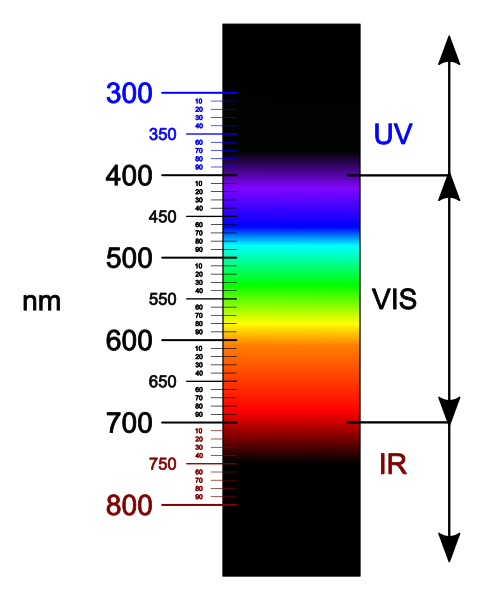
The number of wavelength in the visible spectrum is:
A) $4000$
B) $6000$
C) $2000$
D) infinite
Answer
180k+ views
Hint: In general, there are seven types of the electromagnetic radiations. In these seven types of the electromagnetic radiations, the visible light comes in fourth place. And the visible light has different colours and different wavelengths.
Complete step by step solution:
Electromagnetic waves exist with a large amount of the range of frequencies. This continuous and large amount of frequencies is commonly known as the electromagnetic spectrum. This long range of the spectrum is divided into different types of waves. In electromagnetic waves, there are seven types, they are gamma rays, x-rays, UV rays, visible light, infrared waves, microwaves radiation and radio waves. And these seven types of electromagnetic waves have different wavelengths and different frequencies.
Electromagnetic radiation or waves with a wavelength between $400\,nm$ to $700\,nm$ are called the visible light spectrum. These wavelengths are detected by the human eyes. So, this spectrum is called the visible light spectrum. The wavelengths which are larger than the $700\,nm$ are called infrared waves. And the wavelengths which are smaller than the $400\,nm$ are called ultraviolet waves. Sometimes, these two rays are also called the lights. White light is the combination of the lights of different wavelengths in the visible spectrum. Passing the white light through the prism, it splits up into some colours of light with the wavelength range of the $400\,nm$ and $700\,nm$.

The colour of the visible light is VIBGYOR which means violet, indigo, blue, green, yellow, orange and red. The minimum wavelength is for the violet $400\,nm$ and the maximum wavelength is for the red light $700\,nm$.
Thus, the visible spectrum has an infinite number of wavelengths.
Hence, the option (D) is the correct answer.
Note: The light that excites the human visual system is a very small portion of the electromagnetic spectrum. A rainbow shows the optical (visible) part of the electromagnetic spectrum; infrared (if it could be seen) would be located just beyond the red side of the rainbow with ultraviolet appearing just beyond the violet end.
Complete step by step solution:
Electromagnetic waves exist with a large amount of the range of frequencies. This continuous and large amount of frequencies is commonly known as the electromagnetic spectrum. This long range of the spectrum is divided into different types of waves. In electromagnetic waves, there are seven types, they are gamma rays, x-rays, UV rays, visible light, infrared waves, microwaves radiation and radio waves. And these seven types of electromagnetic waves have different wavelengths and different frequencies.
Electromagnetic radiation or waves with a wavelength between $400\,nm$ to $700\,nm$ are called the visible light spectrum. These wavelengths are detected by the human eyes. So, this spectrum is called the visible light spectrum. The wavelengths which are larger than the $700\,nm$ are called infrared waves. And the wavelengths which are smaller than the $400\,nm$ are called ultraviolet waves. Sometimes, these two rays are also called the lights. White light is the combination of the lights of different wavelengths in the visible spectrum. Passing the white light through the prism, it splits up into some colours of light with the wavelength range of the $400\,nm$ and $700\,nm$.

The colour of the visible light is VIBGYOR which means violet, indigo, blue, green, yellow, orange and red. The minimum wavelength is for the violet $400\,nm$ and the maximum wavelength is for the red light $700\,nm$.
Thus, the visible spectrum has an infinite number of wavelengths.
Hence, the option (D) is the correct answer.
Note: The light that excites the human visual system is a very small portion of the electromagnetic spectrum. A rainbow shows the optical (visible) part of the electromagnetic spectrum; infrared (if it could be seen) would be located just beyond the red side of the rainbow with ultraviolet appearing just beyond the violet end.
Recently Updated Pages
Uniform Acceleration - Definition, Equation, Examples, and FAQs

Difference Between Mass and Weight

JEE Main 2023 April 13 Shift 2 Question Paper with Answer Key

JEE Main 2023 April 11 Shift 2 Question Paper with Answer Key

JEE Main 2023 April 10 Shift 2 Question Paper with Answer Key

JEE Main 2023 (April 8th Shift 2) Physics Question Paper with Answer Key

Trending doubts
JEE Main 2025 Session 2: Application Form (Out), Exam Dates (Released), Eligibility, & More

JEE Main 2025: Derivation of Equation of Trajectory in Physics

Displacement-Time Graph and Velocity-Time Graph for JEE

Electric field due to uniformly charged sphere class 12 physics JEE_Main

Atomic Structure - Electrons, Protons, Neutrons and Atomic Models

Wheatstone Bridge for JEE Main Physics 2025

Other Pages
JEE Advanced Marks vs Ranks 2025: Understanding Category-wise Qualifying Marks and Previous Year Cut-offs

Learn About Angle Of Deviation In Prism: JEE Main Physics 2025

What is Hybridisation in Chemistry?

Nichrome or Manganin is widely used in wirebound standard class 12 physics JEE_Main

JEE Main 2025: Conversion of Galvanometer Into Ammeter And Voltmeter in Physics

JEE Advanced Weightage 2025 Chapter-Wise for Physics, Maths and Chemistry




